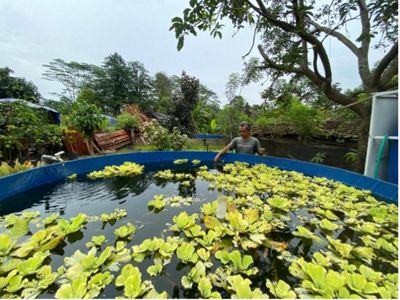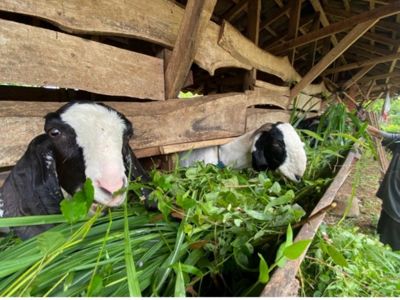Pak Bowo, Menawan Village Nature Preservation Guardian
By Dodi Rokhdian, Community Development Coordinator YKAN
Quote: Mohammad Ribowo, as known as Pak Bowo
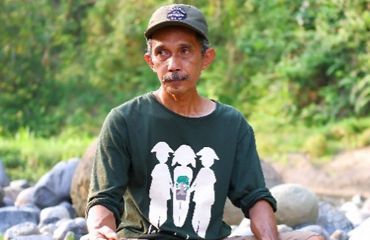
He has a land area of 3,500 square meters, the basis of his household economy. On the land he cultivates as a mixed garden, he practices 'natural farming,' which relies on homemade organic fertilization.
My encounter with Pak Bowo began when I conducted an ethnographic-based study – a methodology from anthropology – at the end of 2018. The study required me to live for a long time (live in) in Menawan Village, at the foot of Mount Muria, Kudus, Central Java, and melt into the daily routine of its inhabitants. The purpose of the study is to understand the perspectives and ways of acting, as well as the relations of the population in managing the natural resources around them. This study became the basis for implementing the SIGAP (Citizens Inspiring Action for Change) approach initiated by YKAN with the Djarum Foundation in villages around Mount Muria.
The Mount Muria area is divided into three districts: Jepara Regency on the west side; sanctuary on the south side; and Pati on the east and southeast; known for its rich biodiversity. Based on data from the Muria University Center for Environmental Studies, 109 plant species from 51 families, 68 bird species, seven mammal species, five reptiles (Widjanarko, 201), and 34 butterflies (Rhopalocera) species (Naim & Hadi, 2018). The results of the YKAN study also revealed that two types of animals are classified as critically endangered based on IUCN criteria, namely the Javan leopard (panther pardus melas) and the pangolin (Manis javanica). Both are priority population recovery animals targeted by the Ministry of Environment and Forestry. In addition, there are six protected endangered species, namely the mouse deer (Tragulus javanicus), forest cat (Prionailurus bengalensis), muncak deer (Muntiacus untjac), langur (Trachypitecus auratus), multi-colored pitta bird (Hydrornis guajanus), and the bido snake eagle ( Spilornis cheela).
Not only has a significant conservation value, but Mount Muria also has a religious significance. Thousands of pilgrims from all corners of the archipelago are busy visiting villages at the foot of Mount Muria to seek blessings. In this area, scattered hermitage locations, petilasan (remains of sacred people), and springs (springs) are considered sacred according to local beliefs. In one of the villages at the foot of the mountain, there is also the tomb of a wali who spread Islam named Raden Umar Said, known as Sunan Muria. This high conservation value, coupled with religious values, underlies the march of life in Menawan Village, where Pak Bowo lives his daily life.
From the Cage Guarding Kali Gelis
The natural farm product garden that Pak Bowo works on has goat pens for him and other farmers. Goat manure is a primary fertilizer for fruit trees such as durian, avocado, guava, mango, banana, and elephant grass that thrive on the land. The production center garden is called the stable by the local people. There are also catfish and tilapia ponds which are mediated by tarpaulin ponds—in the barn, spending time discussing various things because this is where he spends much time managing his farming businesses.
His sustainable farming practices are a way to increase his independence and self-sovereignty as a farmer, "The point is we (farmers) cannot continue to depend on chemical fertilizers purchased from outside. I haven't bought chemical fertilizers for five years. I made it myself, and it has been proven that the plants here produce good crops," said Pak Bowo, explaining his natural farming concept.
He also shares his expertise in sustainable farming practices with other farmers. On several occasions, he is also willing to set aside his time to share knowledge by becoming a speaker in training on making organic fertilizers and plant cultivation to preserve and improve the local farmer's economy. This training is part of the Field School program launched by YKAN to strengthen community capacity.
According to Pak Bowo, sharing knowledge in sustainable agriculture will benefit broader conservation goals. "Instead of keeping it (the knowledge) alone, only my garden is affected. It is different if I distribute it (to other farmers); then it spreads everywhere, and the wider natural environment will be affected," he said wisely.
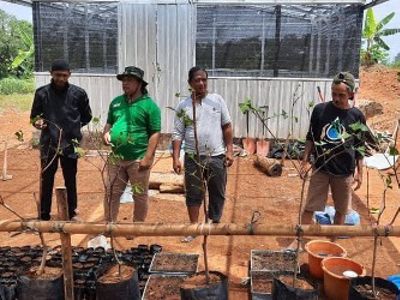
Expelling Excavation C on the Bank of Kali Gelis
The Menawan Village area is traversed by the Kali Gelis river, which originates from the Sendang Bunton spring, which is upstream around the peak of Mount Muria. The Kali Gelis water flow divides the Kudus Regency area with a length of about 32 kilometers, passing from north to south, through several village areas such as Rahtawu in the north, then to Menawan, Soco, Puyoh, Jurang, Besito and ending in the Jati Wetan area. The stream irrigates the villagers' agricultural land and, in the past, has been a means for residents to fulfill various basic needs. "However, Kali Gelis is not what it used to be. There was much damage, and the water is not as clear as it used to be," said Pak Bowo.
According to him, the cause of the damage to Kali Gelis is due to the mining activities of Galian C, which has been operating in his village since the 1980s by dredging rocks and sand and dredging river banks without regard to environmental sustainability aspects. As a result, people's plantations and rice fields are affected by flooding during the rainy season. In some parts, it is difficult for residents to access water because the river banks are being dredged, so they become steep and challenging to pass.
Since the 2000s, mining activities have stopped operating. Thanks to a wave of protests by residents led by Pak Bowo and the local Karang Taruna. The residents in Menawan Village still remember the strenuous efforts to preserve the Gelis River through demonstrations expressed by the residents through Pak Bowo's leadership. One resident said that Mr. Bowo's fearless leadership became the determinant of the cohesiveness of the residents when he stopped Mining C mining activities in Menawan Village.
The challenge of preserving Kali Gelis and its surroundings continues beyond here. The landslide disaster that occurred in 2014 in Kambangan Hamlet, Menawan Village, claimed 12 victims. Disasters were triggered by high rainfall for days and indirectly by deforestation of the forest and surrounding land due to the lack of trees. The disaster sparked Pak Bowo's awareness to activate further and pioneer conservation activities in the Menawan Village area by initiating conservation activities in collaboration with several parties who have the same concern.
Rehabilitating Land and Planting Trees on the Banks of the Gelis and Selobrojo Rivers
More than a decade after the landslide disaster in Menawan Village, at the end of 2020, Pak Bowo has become a key figure in smoothing the rehabilitation program for critical land in Menawan Village, which the Djarum Foundation and YKAN initiated. Through his leadership and militancy when socializing and explaining program objectives, as well as his tireless efforts in organizing farmers, the rehabilitation program was finally implemented in Menawan Village.
Land rehabilitation was carried out during 2020-2023 and has taken place in two phases. In the first phase, the rehabilitation area will be 19.3 hectares, and in the second phase will be 69.8 hectares. In total, an area of 89.1 hectares has been rehabilitated by planting 9,750 fruit tree seedlings and involving 293 farmers. Farmers have grown and cared for most fruit trees on their lands. Even though there were many obstacles and shortcomings, this land rehabilitation program was able to be carried out thanks to Mr. Bowo and his colleagues' ability to encourage the farmers.
In parallel with the rehabilitation activities in Menawan Village, Pak Bowo and the conservation community on the banks of the Gelis River will also carry out a tree planting movement in 2021 along the 2-kilometer banks of the Gelis River and 1.5 kilometers along the banks of the Selobrojo River, a tributary of the Gelis River. The planting of 1,200 tree seedlings consisting of kebo rubber, banyan, aren, pucung, gayam, and cashew nuts was initiated by the residents' anxiety about the reduced source of clean water in the areas of two villages, namely Menawan Village and Soco Village. Now, most of these plants have grown, and their development and maintenance are regularly monitored by the community conservation group led by Pak Bowo.
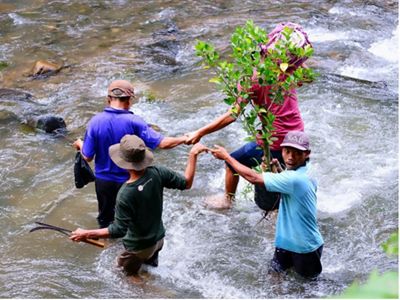
Pak Bowo's work as the initiator of conservation activities in Menawan Village does not stop at rehabilitation and planting activities on the banks of the river. He is also involved in activities to restore the endemic fish species of Kali Gelis, which are now disappearing. In mid-2022, he and the Kali Gelis Conservation Community and the local village government released 5,000 endemic fish fingerlings into the Kali Gelis river.
Returning Past Romance
A cool breeze from the northern area of Menawan Village accompanied my conversation with Mr. Bowo in early 2023, which took place in his stable. Durian season has just ended. While enjoying coffee at the Farmer's Hut in the kendang area, Mr. Bowo reconsidered every trace of the conservation activities he had carried out.
He admits that the nature of Menawan Village, which used to be sustainable, is indeed challenging to restore to its original condition. The conservation efforts that have been carried out are only small steps to restoring the romance of the beautiful past of Menawan Village. When the river flows clearly, the environment around the green royo-royo is filled with various trees.



